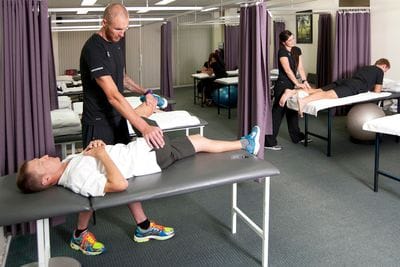Runners KneeWritten on the 11 December 2013 by Active Body Physiotherapy ITB Friction Syndrome, Runner's Knee is the common name for Iliotibial Band Friction Syndrome, a painful overuse condition that affects the outer part of the knee. The iliotibial band is a tough, thick connective tissue (or fasica) extending from the tensor-fascia-lata muscle at the side of your pelvis to the outside of your shin bone. Runner's knee results from repeated friction of this band over the bony prominence at the widest point of the thighbone, called the lateral femoral epicondyle. You're more at risk of this injury if you're in a phase of heavy training, getting in more miles than is normal for you. Weakness of the hip abductor muscles – the ones that draw your leg away from the centreline of your body – can also make runners knee more likely. So can over-pronation or leg length discrepancy, which can be either anatomical or caused by running on cambered roads or always in the same direction around the track. Typical symptoms include pain on the outside of your knee; tightness in your iliotibial band; knee pain thats aggrevated by running, especially downhill; and pain when you bend or straighten your knee, particularly when you press in at the side of the knee over the sore part. How Do I Avoid It?There's a lot of action you can take to avoid runner's knee. To start with, make sure you build up your training volume and intensity gradually, increasing each by no more than 10 per cent a week. Also, ensure you have the right shoes for your foot type, and that they are in good condition. A specialist running shop or your physiotherapist will be able to advise about this. If you have one leg more than 1cm longer than the other, insert a 'build-up' insole on the shorter side (see a physio or podiatrist). Vary the surfaces you run on too, avoid cambered roads, and alternate the direction you run around the track to ensure that one leg doesn't get more stressed. Make sure you stretch after your runs, especially your glutes and hip muscles to prevent the iliotibial band becoming tight. Include a regular strength and stability programme in your training. Also, check your bike fit. Badly positioned cleats, a saddle that's too high or pedals without any float (foot movement before your cleats unclip) can all contribute. Finally, listen to your body. If you're in pain, find out why. If you ignore it, things might get worse. And If I Get It?If you think you have Runner's Knee, first see a physiotherapist. You may need to back off your training. Take a look at your bike too. Check that your saddle is the right height or get a detailed bike fit from a qualified specialist. Deal with any inflammation by applying ice or doing ice massage for 10 – 15mins, three times per day. Once the inflammation is under control, you can free-off restrictions in the muscles and fascia around the knee, thigh and hip. A physiotherapist can do this; self massage and use of a foam roller are other options. Stretch your thigh and hip muscles, particularly the glutes and tensor-fascia-lata muscles, holding each stretch for 30 seconds and repeating three times. As the symptoms ease, begin strength and stability training for the hip muscles. Good options are slow one-legged squats, clam exercises and dips. Then, begin a gradual return to running, initially with fast strides, then slowly increasing distance and volume. This way, you're likely to recover within six weeks.
The team at Active Body is more than happy to help you with any questions, treatment or rehabilitation you require regarding ITB friction syndrome, or any other concerns or injuries you may currently have. Author:Active Body Physiotherapy |
Latest Blog
Runners' Injuries: Patellofemoral Pain Syndrome
Aug 03 2018
Don't let the front of your knees keep you back from running
Continuing on as par...
Runners' Injuries: Achilles Tendinopathy
Jul 24 2018
Running to a pain-free winter
Running is great! It gets you active and moving, strengthens...
Hamstring Strains
Apr 03 2018
Most people, especially those involved with sports like soccer or AFL, will have experienced o...

Quick Links |
| |||||||
Newsletter Signup
Active tips to protect yourself from sports injury. Body awareness






